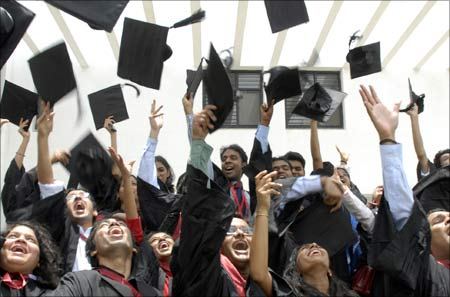The High GDP Growth And Low Employability Anomaly In Indian Higher Education Sector

The high GDP growth rates of India relative to the rest of the world should normally lead to higher demand for higher education. During the late 2000s, there was a lot of talk of how low GER’s may impede growth; however today we are in a situation where there is huge underutilised capacity in the higher education sector despite decent macro-economic growth.
The premium and top decile institutes continue to get large number of admission applications. Students in these institutes generally get jobs commensurate to the cost of education and these institutes manage to command a premium compared. That is par. Top 10% institutes all over the world find it easy to get students.
The problem is that, while in other countries only the bottom quartile has student intake problems; in India, for more than 90% of the higher education institutes there is a shortage of applications and seats go vacant. This despite the fact that India’s Gross Enrolment Ratio in the ages 17-27 compares unfavourably not just with global benchmarks but also with many emerging economies. High growth, low GER and low student interest in professional higher education institutes is a precarious situation to be in.
The massive underemployment of graduates and the concomitant reduced student intakes in the laggard professional institutes is because lack of employability (rather than lack of employment opportunities) and hence poor returns on investments on higher education for students (as a result of higher cost of education relative to expected remuneration levels for students passing out).
Macro-economic indicators suggest that there is an intrinsic opportunity to revive the sector. Indian Higher Education institutes need to introspect and re-invent themselves to correct this anomaly. There are a few dimensions the institutes will have to review before they start improving their academic and financial outcomes.
First, institutes must realise that students are not taking admission because they lack confidence in the institutes ability to provide industry relevant education to churn the students enough to make them employable. Academic rigour and industry connect, which is missing in most institutes, is the only sustainable way of getting out of the poor student intake-poor placement-poor student intake vicious cycle and to create a sustained pull factor for student enrolment. There is massive short supply of quality institutes; and institutes should focus on improving their quality quotient as an end in itself. Putting admissions above academics is putting the cart before the horse, and that will never be sustainable.
Secondly, education groups need to understand that the education sector has matured to some extent. The returns and pay-back period will necessarily be similar to other industries. Gone are the days when institutes had a minimal pay-back period and 100% plus return on promoter investments. The biggest cause of poor quality is short investment horizon of institutes. Depending upon the type of course and geographical location, mid-rung institutes need to plan a 2-4 year time frame for operational cash break-even and a 5-10 year pay-back period for capital investments. The irony is that, while promoters had planned for short investment horizon reduce their perceived risks, in effect their long term risk substantially increased as most mid-rung organisations generate negative returns, if the cost of capital is factored.
Thirdly, institutes need to make sure that the courses are rightly priced. Globally the accepted norms is that the expected first year salary offered should be 80% to 120% of the total cost of education. However, a large number of Indian higher education institutes compare unfavourably to this metric. For example, there are many private universities where students pay more than Rs. 15 lakh to complete a two-year management degree, but the students may struggle to get a job with a salary of Rs. 5 lakh per annum. The numbers for engineering colleges are equally bad.
Fourth, the institutes must improve business models – i.e. innovate to improve revenue streams and focus on process efficiencies to reduce costs. Unfortunately, most of the promoters do not have significant domain knowledge. That, coupled with limited risk-taking abilities are preventing them from noticing the nooks and niches to innovate and mould business models to create new revenue streams. Consulting, research, vocational education, outreach are some of the many options that are under leveraged. Similarly, most institutes do not have adequate focus on process efficiencies and cost structures. Benchmarking, re-engineering and technology offer many options. However institute management is still based on intuition and institutes do not proactively use management science to look for differentiation or efficiency enhancement.
Fifth, and I have purposefully kept it at the end, is the poor regulatory framework. The sector demonstrated exponential growth in late 1990s and early 2000s because of regulatory de-bottlenecking; but insipid governance and misdirected regulation spoiled the party thereafter. I have put it at the end, because I feel large proportion of institutes can improve their lot despite the regulatory weaknesses.
There is an opportunity in the segment which can be leveraged if institutes look to reinvent themselves by focusing on creating long term value for the students. To do this the key is focussing on quality, increasing the investment horizon, reviewing curriculum – teaching what the industry is prepared to pay for, reviewing the fee structures, innovating to embrace new revenue streams and reducing costs through process re-engineering and/or technology.

Comments are closed.